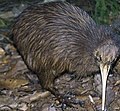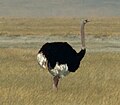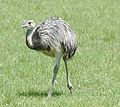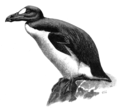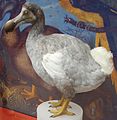Difference between revisions of "AY Honors/Birds/Answer Key"
| Line 95: | Line 95: | ||
==4. Write or give orally three ways in which God's love and purpose is shown in the creation of birds.== | ==4. Write or give orally three ways in which God's love and purpose is shown in the creation of birds.== | ||
==5. Make a list of thirty species of wild birds, including birds from at least five different orders, that you personally have observed and positively identified by sight out of doors. == | ==5. Make a list of thirty species of wild birds, including birds from at least five different orders, that you personally have observed and positively identified by sight out of doors. == | ||
| − | + | Please consult Wikibooks' [[Field Guide/Birds|Field Guide to Birds]] to help you identify some birds. As of this writing, this field guide is still in its infancy, so you might be well served to purchase a more thorough field guide. Field guides are generally tailored to a specific area of the world, so be sure to consult one that covers your area. | |
==6. Make a list of five species of wild birds that you personally have positively identified by sound out of doors. == | ==6. Make a list of five species of wild birds that you personally have positively identified by sound out of doors. == | ||
Revision as of 12:07, 3 April 2007
1. Give two characteristics which set birds apart from all other creatures.
It is often useful to compare features of groups creatures to see what is the same as other creatures, but in order to identify them, it is useful to find the differences as well. There are five classes of creatures with a backbone. These classes include the fish (Agantha), amphibians (amphibia), reptiles (Reptilia), birds (Aves), and mammals (Mammalia).
All of the vertebrata have a backbone, but birds have a number of unique characteristics such as:
- Flight
- Hard shelled eggs
- Warm blooded
- Covered with feathers
- Hollow bones
- Bone structure in the eye
- Keen eyesight
- Musical voices
- Ability to sense magnetic fields
- Very Colorful
Each of these things seems quite unique, but as we look at the other classes of vertebrata, we find that birds are not the only creatures that can fly. There are flying fish, gliding snakes, gliding frogs and bats. Each class of vertebrates has the capability of crude flight, and bats at least can match the flight ability of the birds. We must also note that not all birds are capable of flight (penguins, ostriches and others are incapable of flight).
Mammals are warm blooded, so that is not unique to birds. Whales, frogs and some of the primates have very musical voices, although few can compare to the Lyrebirds of New Guinea or even a simple Northern mocking bird. Many of the mammals such as meerkats have good eyesight, so this is not unique, and most fish have the ability to sense electro-magnetic fields.
When we have compared the various classes, we find that there are only a few things that are unique to the class Aves.
- They all lay hard-shelled eggs which they incubate using their body temperature.
- They all are covered with a feather structure that differs greatly from scales and fur.
- Hollow bones allow them to fly almost effortlessly.
- A ring bone in the eyes of birds is what allows them to focus so well and have such keen eyesight.
All of these characteristics give us an idea of what makes birds unique and also an idea as to why we are so drawn to these colorful, flying creatures.
2. Name three flightless birds, tell what their diet consists of, and name the country or continent in which each one lives.
The Alca impenis (Great Auk) and the Raphus cucullatus (Mauritius Dodo) are pictured with the other flightless birds because they were flightless birds that faced many of the same dangers of some of the current flightless birds such as the Apteryx (kiwis). Man and animals that come with man such as dogs, pigs, cats, and rats are very dangerous for any birds that nest on the ground. Many flightless birds have become extinct because of man and his actions. These two species represent a far larger number that have become extinct at the hand of man.
Cassowary
- Cassowaries are native to the tropical forests of New Guinea and northeastern Australia. Some nearby islands also have small cassowary populations, but it is not known if these are natural or the result of the New Guinea trade in young birds. They are frugivorous; fallen fruit and fruit on low branches are the mainstay of their diet. They also eat fungi, snails, insects, frogs, snakes and other small animals.
Emu
- The Emu is the largest bird native to Australia. They eat a variety of plant species; the type of plants eaten depends on seasonal availability. They also eat insects, including grasshoppers and crickets, lady beetles, soldier and salt bush caterpillars, cotton-boll moth larvae and ants.
Kiwi
- Kiwis are from New Zealand. They eat small invertebrates, seeds, grubs, and many varieties of worms. They also may eat fruit, small crayfish, eels, and amphibians. Their long beaks, with nostrils at the end of them, help them to catch prey.
Ostrich
- Ostriches live in the savannas of Africa. They mainly feed on seeds and other plant matter; occasionally they also eat insects such as locusts. Lacking teeth, they swallow pebbles that help as gastroliths to grind the swallowed foodstuff in the gizzard. An adult ostrich typically carries about 1 kg of stones in its stomach.
Penguin
- Penguins are aquatc birds living exclusively in the Southern Hemisphere. Most penguins feed on krill, fish, squid, and other forms of sea life caught while swimming underwater. They spend half of their life on land and half in the oceans.
Rhea
- Rheas are native to South America. They are omnivorous, preferring broad-leafed plants, but also eating seeds, roots, fruit, insects, and small vertebrates.
3. Give the day of the week when birds were created. Find in the Bible the names of five birds and be able to name them from memory.
Birds were created on the Fifth day - see Genesis 1:20-23
Pelican, Raven, Owl - Isaiah 34:11
Chicken - Matthew 23:37, Luke 13:34
Eagle - Jeremiah 49:22, Jeremiah 4:13, Job 9:26, Deuteronomy 28:49, Job 39:27-29
Ostrich - Micah 1:8
Dove - Genesis 8:8-11, Matthew 10:16, Hosea 7:11
Eagle, Buzzard, Kite, Falcon, Raven, Ostrich, Owl, Sea Gull, Hawk, Little Owl, Cormorant, Great Owl, White Owl, Pelican, Vulture, Stork, Heron, and Hoopoe- Leviticus 11:13-19
Peacock - 1 Kings 10:22
Raven - 1 Kings 17
Partridge - Jeremiah 17:11
4. Write or give orally three ways in which God's love and purpose is shown in the creation of birds.
5. Make a list of thirty species of wild birds, including birds from at least five different orders, that you personally have observed and positively identified by sight out of doors.
Please consult Wikibooks' Field Guide to Birds to help you identify some birds. As of this writing, this field guide is still in its infancy, so you might be well served to purchase a more thorough field guide. Field guides are generally tailored to a specific area of the world, so be sure to consult one that covers your area.
6. Make a list of five species of wild birds that you personally have positively identified by sound out of doors.
The Field Guide to Birds has "bird call" links for several birds (though it is not yet exhaustive). Listen to the most common birds in your area so that you may learn to identify them by their calls. Many birds (such as the woodpeckers and the Bobwhite) are a lot easier to identify by their calls, because they are so much easier to hear than to see.


